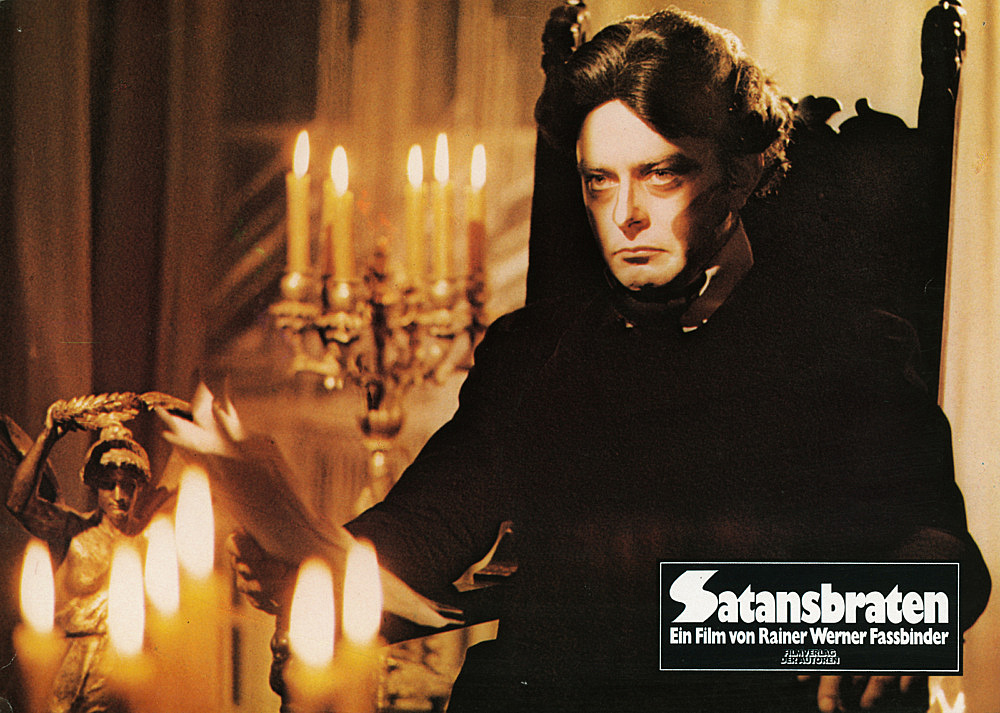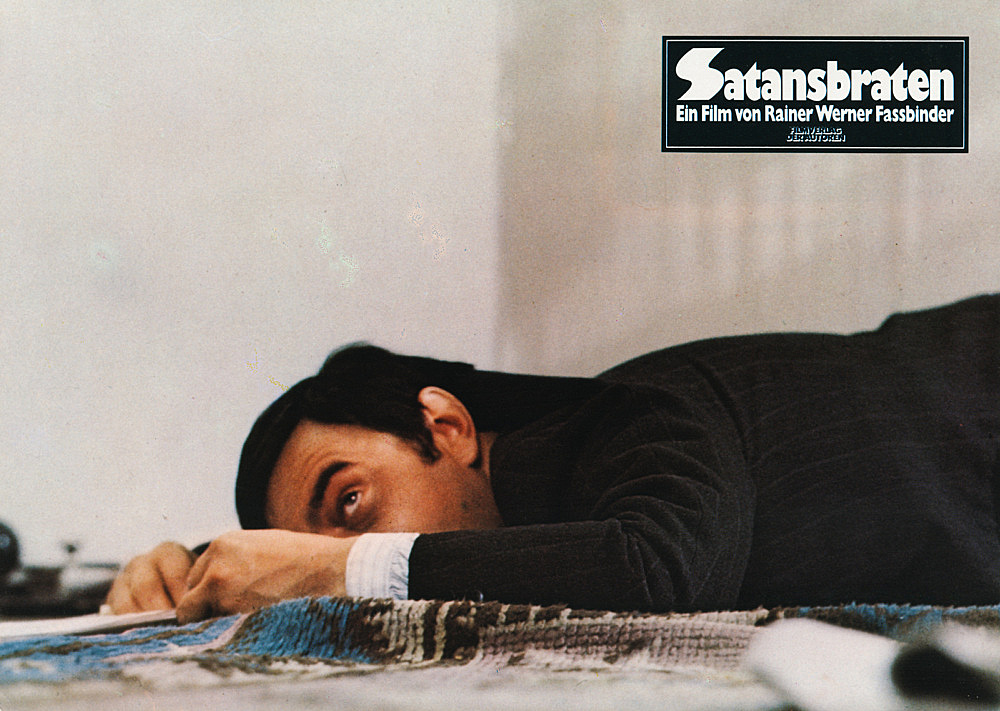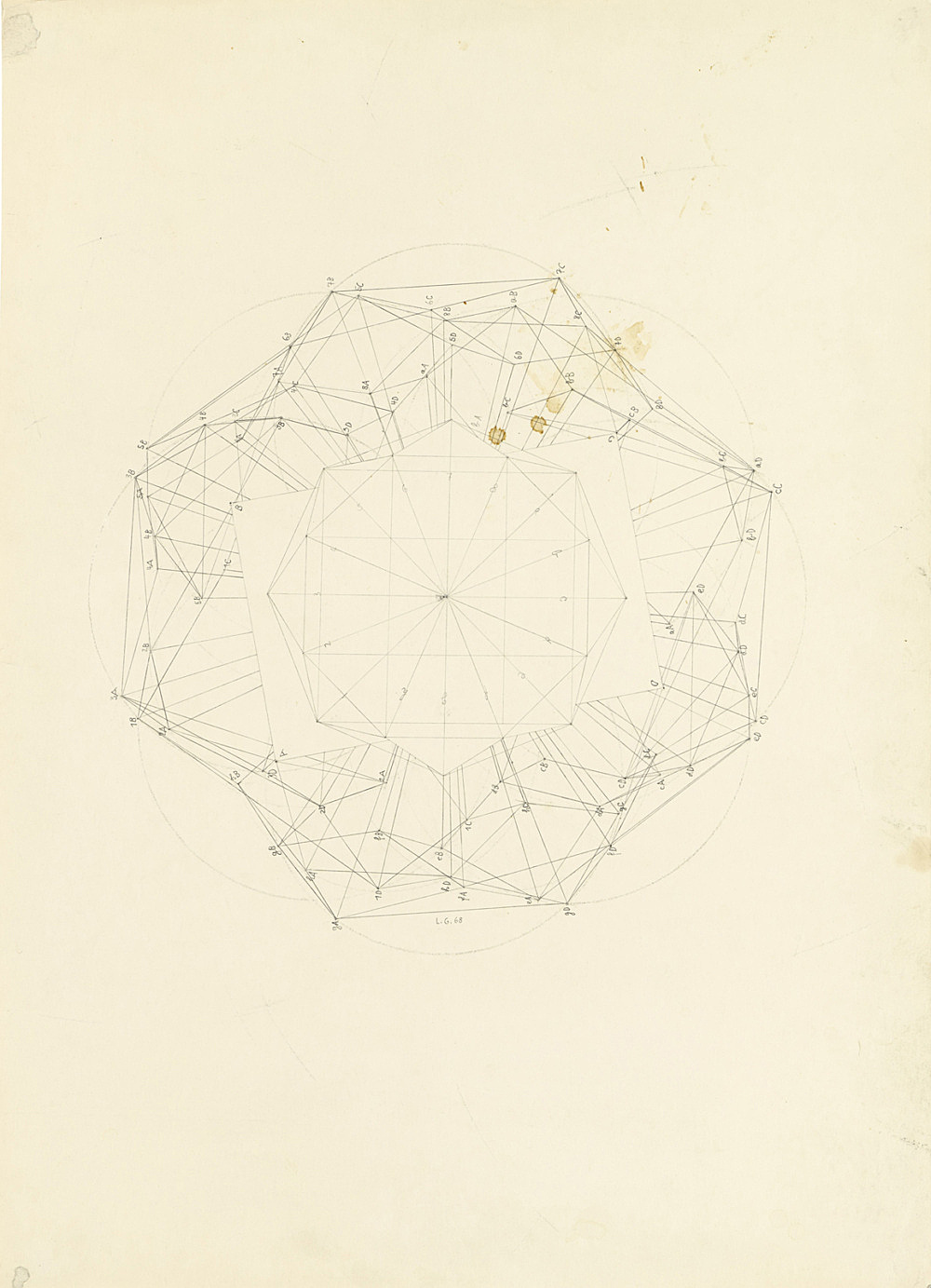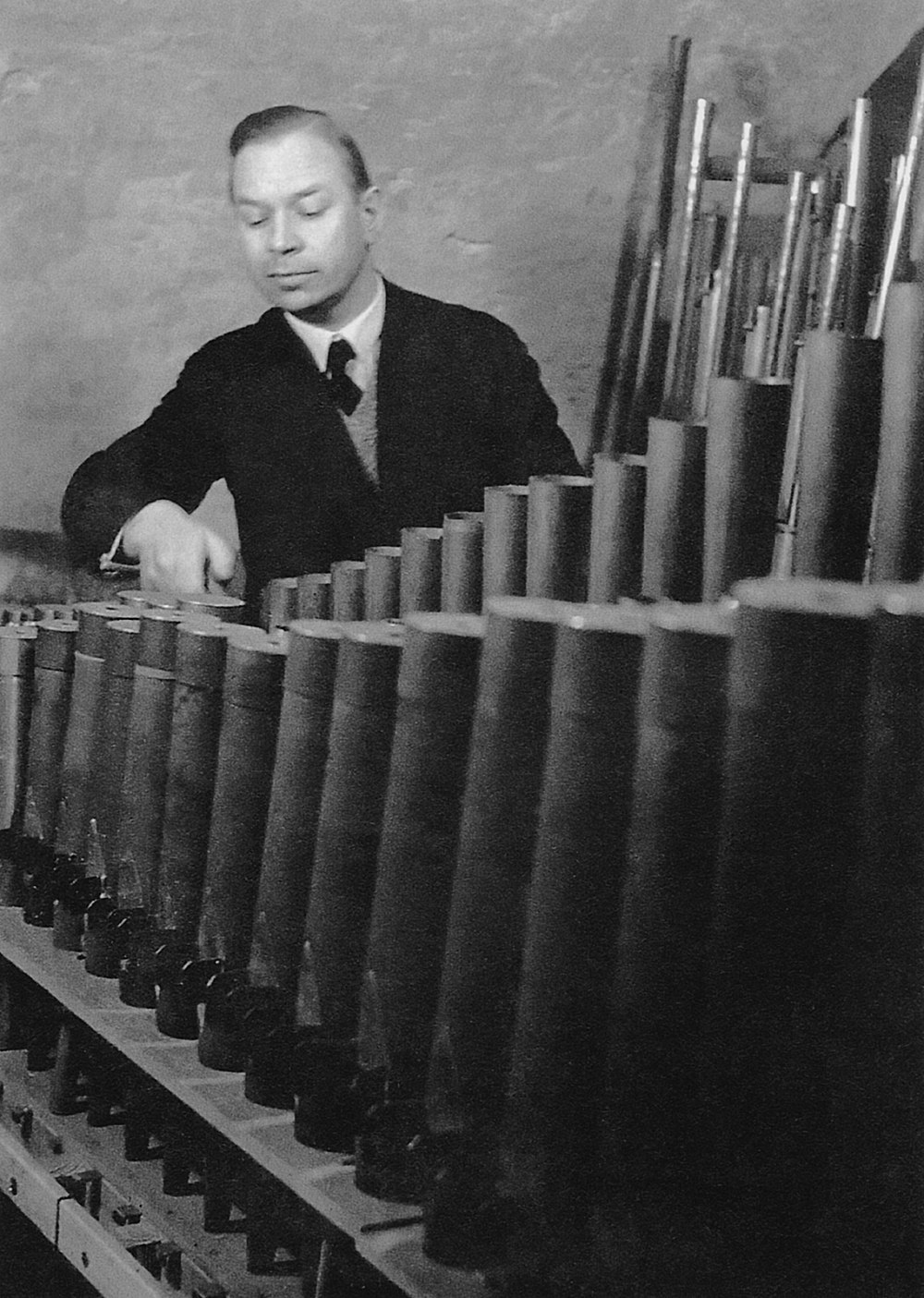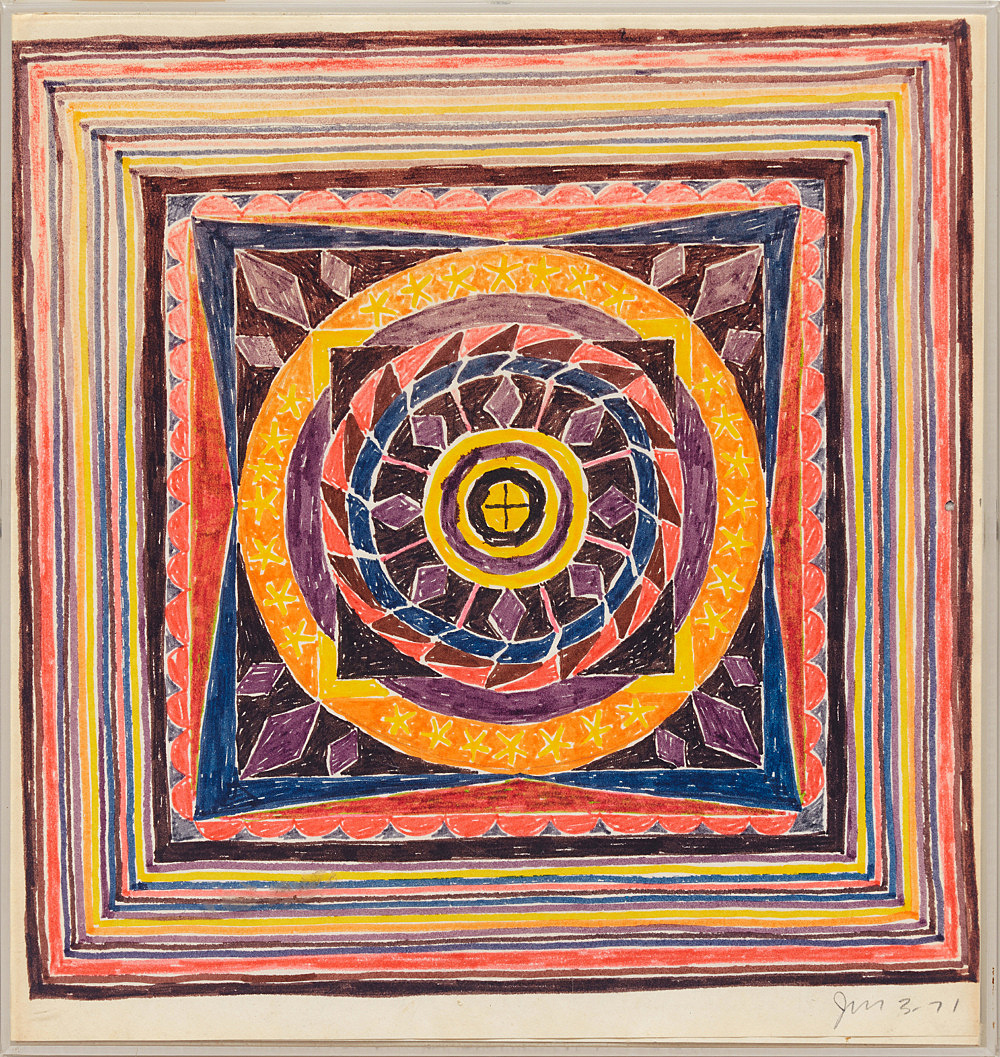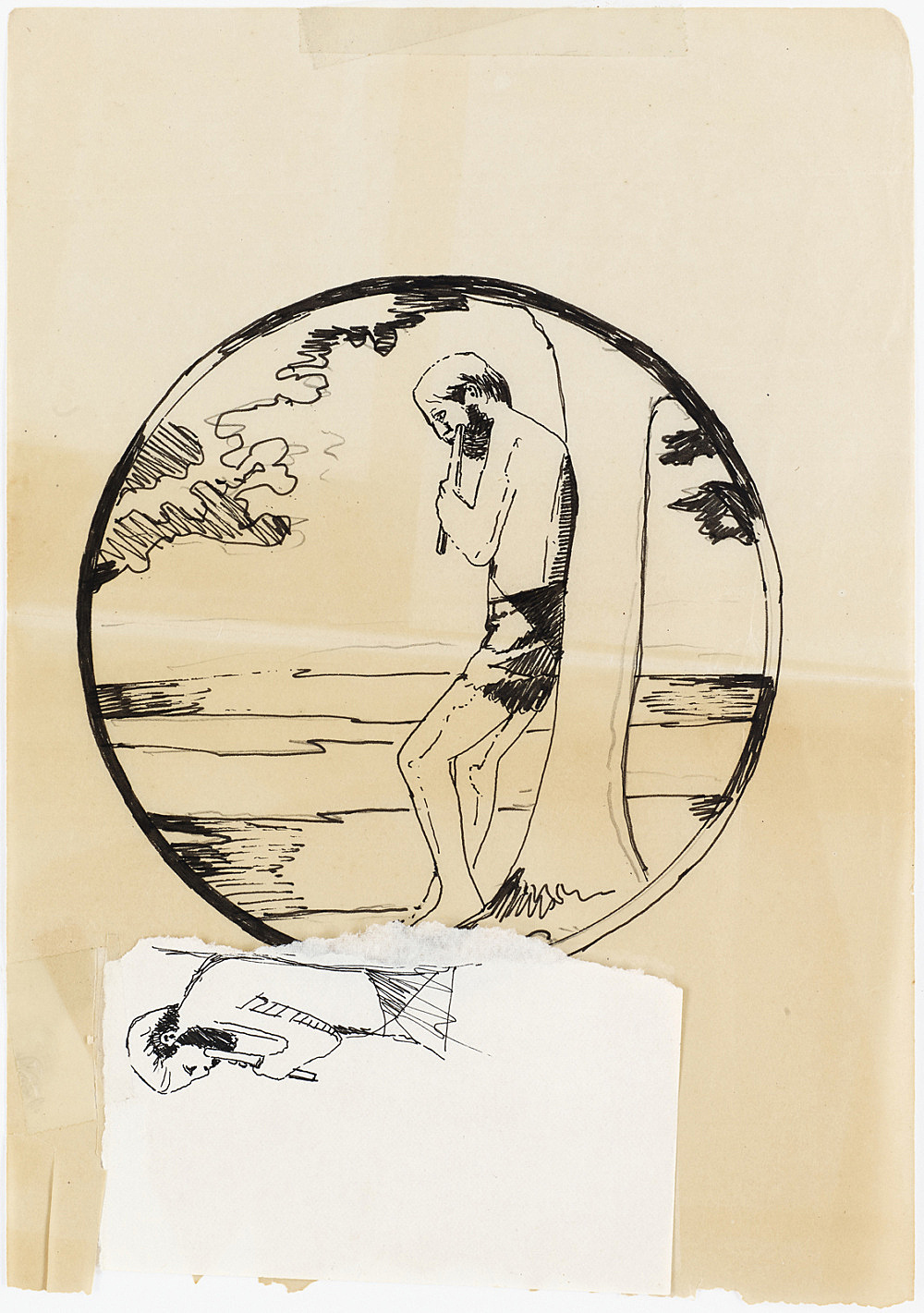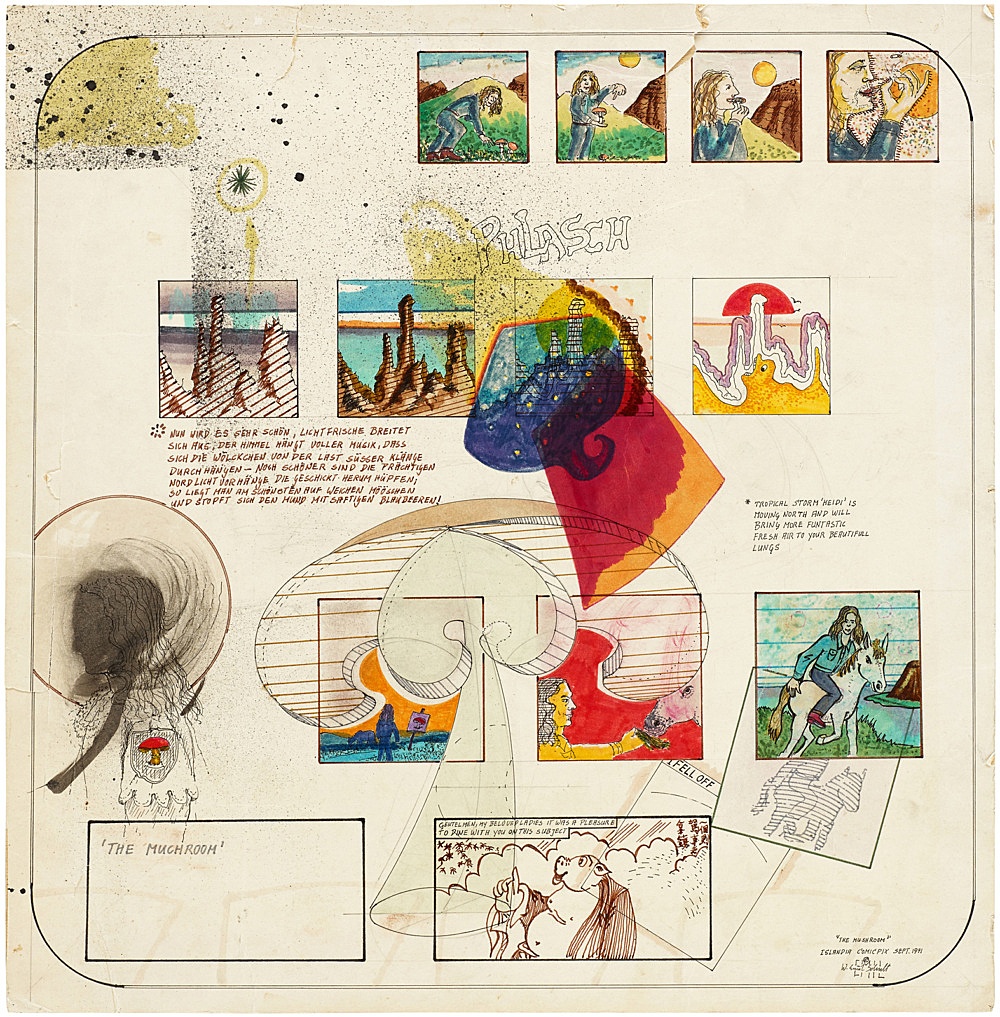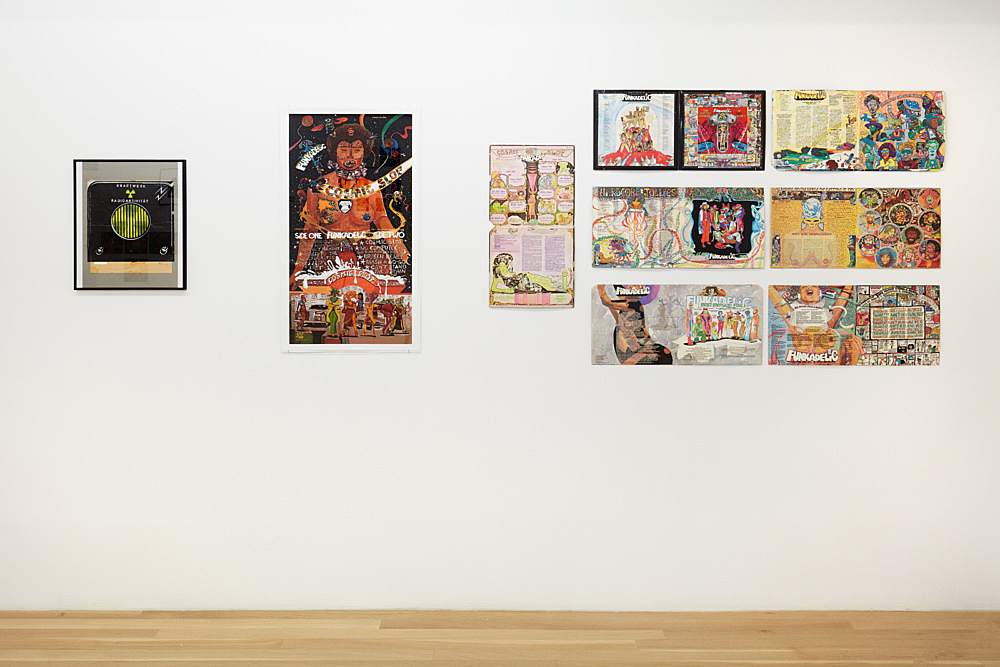
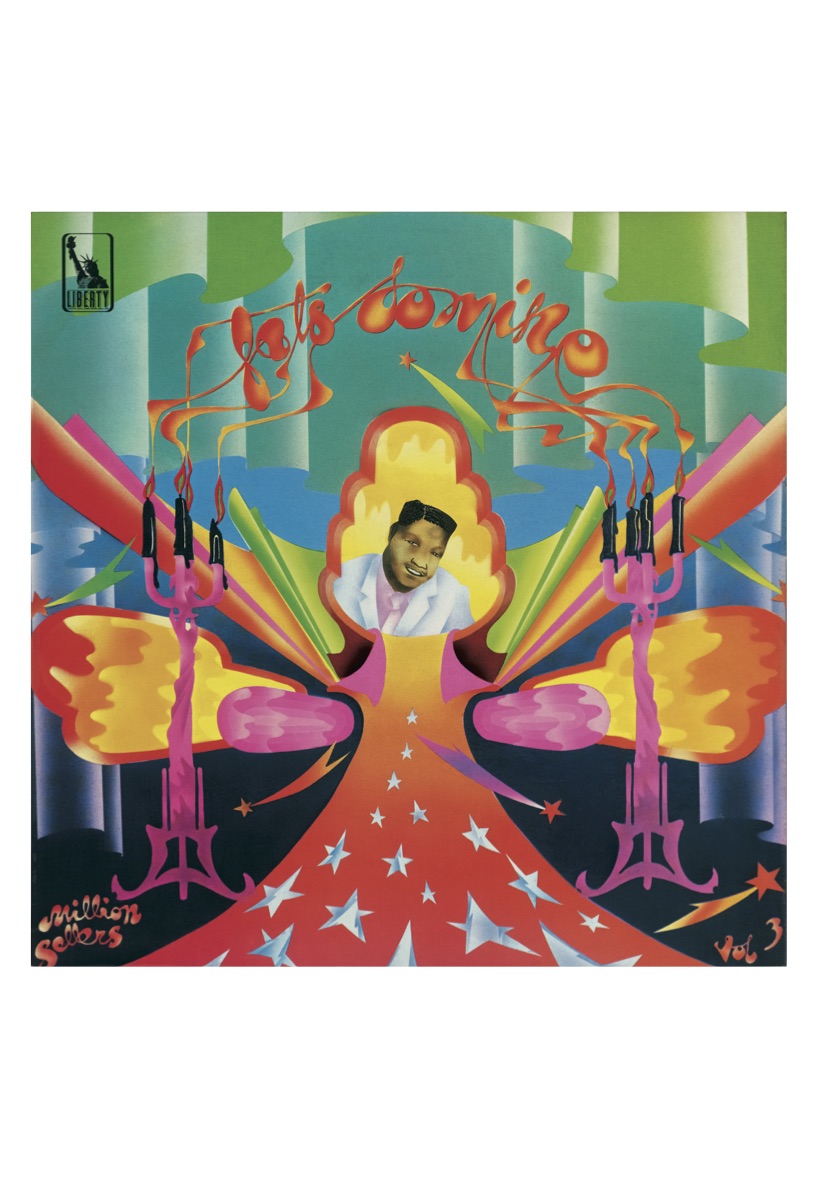
Cosmic Communities: Coming Out Into Outer Space
- Homofuturism, Applied Psychedelia
& Magic Connectivity
an exhibition organized by Diedrich Diederichsen &
Christopher Müller
feat.
Marcus Behmer, Stefan George, Rainer Werner Fassbinder, Hans Henny Jahnn, Lutz Bacher, Hans Kayser, Ludwig Gosewitz, Jordan Belson, Hapshash and the Coloured Coat, The Fool, Rogério Duarte, The Red Krayola/Mayo Thompson, Walter de Maria, Sigmar Polke, Emil Schult, Isaac Abrams, John McCracken, Pedro Bell, Kai Althoff, Henrik Olesen, Öyvind Fahlström, Karlheinz Stockhausen, Sun Ra, Hartmut Geerken, Albert Oehlen, Jack Goldstein, Jutta Koether, Isa Genzken, Palermo, John Coltrane, Tony Conrad
13 January 2018
opening reception on Thursday,
2 November 6-8 pm
Cosmic Communities: Coming Out Into Outer Space
- Homofuturism, Applied Psychedelia
& Magic Connectivity
an exhibition organized by Diedrich Diederichsen &
Christopher Müller
feat.
Marcus Behmer, Stefan George, Rainer Werner Fassbinder, Hans Henny Jahnn, Lutz Bacher, Hans Kayser, Ludwig Gosewitz, Jordan Belson, Hapshash and the Coloured Coat, The Fool, Rogério Duarte, The Red Krayola/Mayo Thompson, Walter de Maria, Sigmar Polke, Emil Schult, Isaac Abrams, John McCracken, Pedro Bell, Kai Althoff, Henrik Olesen, Öyvind Fahlström, Karlheinz Stockhausen, Sun Ra, Hartmut Geerken, Albert Oehlen, Jack Goldstein, Jutta Koether, Isa Genzken, Palermo, John Coltrane, Tony Conrad
2 November 2017
- 13 January 2018
In General
This exhibition looks at a constellation of historical phenomena that branched out and evolved in various directions. Artists who formulated strong, almost violent, and widely impactful and inspired claims, and who in this sense still bore out the myth of the artist hero, but did so always with the commanding need to form groups, families, or even monastic orders. They sought to change the world through artisanal disciplines, “life reform”-related practices and strict internal rules-yet always in connection with liberating or covertly liberating intentions. We begin with a phenomenon in German literature in the early twentieth century: male collectives, often but not always homosexual but usually homosocial in character, that were interested in aesthetically and often magically based alternative world orders. Among these, we are here primarily addressing the special cases in which the supposed cosmic laws, the musical and mathematical harmonies of planetary orbits, and the numerical ratios that can be found in both nature and music serve as justifications for recasting interpersonal, societal, but also sexual relationships. Ideas of Pythagoras or Kepler here created all-encompassing artistic equivalences which were meant to organize contemporary forms of coexistence as well as important artistic and scientific work, and which were also supposed to give rise to the society of the future.
Many of these groups were politically predominantly reactionary, including the so-called George Circle surrounding the poet Stefan George (1868-1933), while others, such as the community of Ugrino surrounding the organ builder and writer Hans Henny Jahnn (1894-1959), were vaguely left-wing and pacifist. In the typically German philhellenic George Circle, young men were intellectually and often sexually initiated by older members. Ugrino was more a polyamorous commune with a male couple at its center (Jahnn and the musician Gustav Harms), but in fact all of its members had sexual relationships with each other. At the same time, both groups adhered to strict protocols. They shared common ideals with regard to externals-clothing, architecture, and design. Among the youth movements and artists’ groups that existed around 1900, there are a number of other examples that might have been relevant in which sexual and artistic aspirations came together. This exhibition, however, is less concerned with completeness and historical reliability. Rather, we begin with starting points that struck us and follow them, led by similarity and association, to variants and related phenomena or next stages. In doing so, we are often guided by the notion that programs that were not yet articulated politically may, in their aesthetic implicitness, have something to say to later, more political topics of which the authors of those earlier programs were not yet aware. This also means that we are traveling in the slipstream of the para- and proto-political space that Douglas Crimp has described as “queer before gay.”
Both examples-the George Circle and Ugrino-are nearly untapped treasure troves of queer life reform and artistic projects from which a multitude of lines lead first to the neo-avant-gardes and liberation cultures of the 1960s but also into the present. Nevertheless, the two authors who stood at the center of these groups are far from obscure in the German-speaking world. George represented the preeminent link to French symbolism around 1900 and was for a moment close to Mallarmé, while Jahnn was well known as the author of taboo-breaking “omnisexual” (Jahnn), blood-soaked Expressionist dramas and then as the “German James Joyce” for his novels “Perrudja” and “Fluss ohne Ufer” (“River without Banks”).
Juxtaposed with these groups are a number of American groups and individual figures who took a very similar course, albeit in a different context and at a different stage of aesthetic and political development. We recognized parallels with American groups in which a form of musical and mathematical correctness seen as a better, more just order serves as the basis for (unpolitical or proto-political) movements, be it in the cosmic jazz of Sun Ra or in the minimal music of La Monte Young and his circle, which is present here mainly through the work of Tony Conrad, the subsequent critic of precisely these models of order. Sun Ra also led his band, the Arkestra, as a highly disciplined but also utopian sect; its members lived together from time to time like those of Jahnn’s community and were obliged to follow a strict protocol and obey the master. Like Karlheinz Stockhausen, Ra saw a close relationship between aesthetic, social, and technical progress, a relationship, however, that neither musician ultimately wished to cast in political terms but construed as mythical and religious. Stockhausen also sought to control his musicians right down to the way they lived; he took an interest in their diet and often composed scores specifically for certain individuals and their physicality.
Hans Kayser’s (1891-1964) “harmonical” philosophy of music attempted to derive eternal harmonic laws, whole-number proportions, from the scientific and mathematical knowledge of numerical ratios present throughout the universe, for which he claimed to find evidence from as far afield as quantum physics. It not only influenced Jahnn as an organ builder and his architectural plans for Ugrino; it also provided material for Hermann Hesse’s successful utopian novel of a male republic of scholars, “Das Glasperlenspiel” (“The Glass Bead Game”), in which Kayser also seems to appear as a character: “A Swiss musicologist with a passion for mathematics gave a new twist to the Game, and thereby opened the way for its supreme development. This great man’s name in civil life can no longer be ascertained; by his time the cult of personality in intellectual fields had already been dispensed with. He lives on in history as Lusor (or also, Joculator) Basiliensis” (Magister Ludi, “The Glass Bead Game”, trans. Richard and Clara Winston). This novel in turn became one of the most important sources for Karlheinz Stockhausen’s idea of the music of the future and its role in society. The next important book for Stockhausen was the esoteric American “Urantia Book”, which is obsessed with order and organization and whose style is often similar to that of “Das Glasperlenspiel”. Supposedly dictated by higher beings, this book devotes thousands of pages to its account of a vast, highly structured universe, of which the earth and Biblical history are only a tiny part (but are not contradicted), regulated by an intricately organized state made up of millions of angels, redeemers, and other cosmic officials. Stockhausen became acquainted with the book in 1971, the same year as Sun Ra, who also wished to found a new cosmic order based on music as the leader of a musical sect.
Of course, there were a number of artistic movements and collectives in the nineteenth and twentieth centuries that in one way or another thematized, pursued, or merely dreamed of sexual liberation and the suspension of heteronormative structures. But the groups on which we focus in this exhibition have one thing in common: their deviation from the hegemonic sexual order is closely connected with the above-mentioned notions of an ideal order, which were usually but not always derived from music, or with idealized notions of (Greek) antiquity. Most of these groups had their heyday between the late nineteenth century and the 1960s. However, quite recently one can notice the rise of a nostalgic, retrospective interest in their rigor and also in their modernity. Politically and aesthetically, they often oscillate confusingly between a reactionary drift into mysticism and the treatment of art as a quasi-religion on the one hand and social and cultural utopias and gestures of liberation on the other. But precisely this idealization and repression of the utopian content within aesthetic “cover stories” also leads to a kind of preservation effect. In certain visual and auditory genres and elements that were later used in various ways, including psychedelically (such as mandalas, earth circles, globes, circles of fifths, baroque tonality, drones, and overtones), motifs of awakening, expansion, and even liberation are contained, as it were, in coded form. Without being immediately legible, they could have been stored for future use.
At a certain point, these breaks with the Western, bourgeois sexual order-whether pursued by individual artists or in the context of quasi-religious artists’ groups-encountered the sexual liberation of the 1960s as it spread and reached new sectors of society, culminating in Stonewall and the ensuing politicization. When that happened, a shift began to take place from the cosmic order to its psychedelic explosion: a variety of cosmic motifs that now no longer functioned as rigorous notions of order serving as the basis for world views, or as legitimating discourses, but began to proliferate in all directions. This escalation, which benefited from the experience with hallucinogens, the relaxation of sexual prohibitions, and a new market for youth culture, broke, albeit hesitantly, with heteronormative models. The boys, with their long hair, looked like girls; in many sects and groups but also in everyday life in the West (in the broadest sense), other sexual identities were not only conceivable but were actually being lived out. This altered the conditions for artist gurus wishing to form groups and found new worlds. And yet the psychedelic images still betray their origins in the aesthetic contexts from which they are breaking free.
It is true that, with the psychedelic movement on the one hand and the appearance of an overtly queer art on the other, the strict groups seem to dissolve or be swallowed up by sexually and musically liberated hippies. However, many motifs survived without simply being incorporated into the narratives of liberation, and not just in the artistic projects and developments that emerged from the complicated common history of mystical modernists and homofuturists. For us, the diffuse phenomenon of psychedelia is most immediately recognizable in the applied arts, as applied psychedelia: on posters, record covers, and in the aesthetics of everyday life. This is the case not least because the life reform agendas of the movements we thematize also wished to close the gap between autonomous form and (erotic, social) application. For applied psychedelia is “applied” in another sense as well. The artworks, covers and posters, and light shows were intended to be immediately usable; they were supposed to be tools with whose help-and that of drugs-higher states could be directly accessed. In taking a “hands-on” approach of this kind precisely in the spiritual realm, this psychedelic applied art became a twofold scandal for a hegemonic art that prided itself on its refusal to develop any immediate use values but also on its refusal to entertain such intellectually discredited objects as cosmic/musical spiritual orders.
This instrumental or tool-like approach of psychedelic art has a great deal to do with its prehistory in the sects discussed above. After all, the latter were also concerned with fashioning reality, including through architecture, agriculture, instrument making, etc. “Access to tools,” the legendary slogan of “The Whole Earth Catalogue”, was also a fundamental principle for the earlier life-reformers. One can criticize psychedelic art for the fact that its enthusiasm for use value simply ignores the Marxist critique of the commodity, just as one can criticize the sects described above for their religious lunacy. But the scandalous shortcut to higher consciousness represents a subversive and effective protest against the peace that official autonomous modernist art seemed to have made with the commitment to never again come anywhere near a use of the aesthetic.
And yet the attempts of the psychedelic arts to extract immediate use values precisely from cosmic/magical representations and interventions are not necessarily anti-modernist. They run counter to a general idea of progress without abandoning it. They continue to be concerned with improving conditions that-as in the newly rediscovered phenomenon of Soviet cosmism-cannot be conceived without the potentially metaphysical side of the material framework of human existence. By the 1970s at the latest, electronics in music and data transmission are regarded as both technologically advanced and also divine; this is the case for Stockhausen as well as for Kraftwerk and the drawings and designs of Emil Schult, who produced the group’s album covers. Isa Genzken’s “Weltempfänger” (“World Receivers”) and Kraftwerk’s “Radio-Activity” are seen by their authors very much as extensions and prostheses of the psychedelic and cosmic/“harmonical” endeavors-even if they seem to have lost sight of the profoundly societal dimension of the idea of progress. And yet the latter can be recognized as a hidden-and therefore protected and stable-deeper level precisely in their aesthetics of an “impossible” use value, which is nonetheless a type of applicability.
It is not the intention of this exhibition to document any of its historical examples exhaustively. Rather, it displays artworks and symptomatic artifacts that appeared to us as having been produced under their influence and then pursues particular motifs, sometimes on a whim and without always having good reasons for doing so. These motifs include notions of ideal, direct communication through magic, technology, sexuality, or wireless transmission; images of Pythagorean and Platonic systems and graphic attempts to visualize totality; and explosions of color, especially involving the use of prefabricated implements outside the realm of painting (felt-tip pens, boxes of watercolors).
The exhibition seeks to grasp the two principal phases-the harmonically based cosmic/musical life reform that held sway between 1900 and 1960 and the applied, psychedelic explosion of the material from 1960 onward-as precursors of a politicization of sexual liberation that to some extent began in the 1970s and to some extent still remains to be carried out. These precursors generated a rich and for the most part implicit aesthetic material that could be further utilized and expanded in the spirit of its implicit liberating tendency-fascinating material, but that also has to be emphatically refuted. Tony Conrad does so in “Slapping Pythagoras”, where he depicts the attempt to base the world and music on a common cosmic and mathematical order as an anti-democratic tradition (which substitutes “a Theology of Numbers for the pragmatics of counting”). Rainer Werner Fassbinder does so in “Satansbraten” (“Satan’s Brew”), when he makes fun of the rites and rituals of the George Circle as a sexually inhibited, petit bourgeois theologization of (gay) sexuality.
In Particular
Stefan George (1868-1933) idealized and idolized very young men, whom he sought to initiate into his circle. Many remained attached to it for decades and often saw themselves replaced by younger disciples. They were able to assume other functions, however, and the circle produced a number of authors and literary scholars. George idolized Maximilian Kronberger (1888-1904) with particular intensity, giving him the pet name Maximin.
Marcus Behmer (1879-1958) belonged as early as 1903 to one of the world’s first homosexual organizations and was for a short moment associated with the George Circle, despite the fact that George disapproved of coming out. A number of the circle’s members can be seen in his drawing “Prometheus”, which depicts George himself as a reaper, along with Karl Wolfskehl (1869-1948) and Friedrich Gundolf (1880-1931).
Rainer Werner Fassbinder’s “Satansbraten” (“Satan’s Brew”, 1976) tells the story of a German poet who, after an episode of creative blockage, begins to believe he is Stefan George and pays young male prostitutes from the Munich central railroad station to reenact the George Circle’s ritual readings with him.
Hans Henny Jahnn (1894-1959) attempted to found a utopian community, “Ugrino”, that, in addition to poetry and literary production, would also devote itself to architecture and above all sepulchral architecture, as well as to baroque music prior to Bach. Early on, his work as a writer brought him into conflict with the bourgeois public of the 1920s-his dramas contained all kinds of sexual practices considered deviant at the time, including incest and self-mutilation. Jahnn self-trained as an organ builder and found in that craft a confirmation of the numerical ratios proclaimed by Hans Kayser that he had derived from observations of botany and nature. These numerical ratios became an organizing principle he felt should be followed in the architectural plans for Ugrino. At the center of Ugrino was the relationship between Jahnn and the musician Gottlieb Harms. Later, the group was increasingly joined by women, who also had sexual relationships with each other, as well as by young men, including the writer Hubert Fichte, who was discovered by Jahnn at the age of fourteen in 1949, and the composer Yngve Jan Trede.
Organ pipes and their proportions are also on view in the exhibited work by Lutz Bacher. This work suggests a combination of Jahnn’s utopia of structural relationships with Sun Ra’s models of world order, which were also based on the keyboard. At the same time, the principle of the keyboard was criticized by La Monte Young and other proponents of a “just intonation” that operates exclusively with whole-number ratios-a criterion that is not fulfilled by the equal intervals of Western keyboards. Tony Conrad, who also initially worked on “just intonation,” later rejected this musical system as well, criticizing its justification of order and hierarchy.
Primarily known as a glass artist and related to the Fluxus milieu, Ludwig Gosewitz (1936-2007) dealt all his life with geometric themes in connection with objects that are normally not accessible to them, particularly life stories and music, generally using astrological computational models. Paradoxically, he too developed a highly personal artistic practice from these large-scale, supposedly objective parameters.
Isaac Abrams (b. 1939) has always emphatically regarded himself as a psychedelic artist; in this, he represents an exception. Abrams has described his experiences with hallucinogens as simultaneously involving the perception of a new and undreamt-of inner life and of a balanced cosmic order, and thus as simultaneously combining order and explosion. This is typical of the new generation of the 1960s, for whom the fiction, vision, or construction of ideas of cosmic order is no longer called upon to legitimize and compensate for secret, clandestine, or forbidden practices of cohabitation, sexuality, and art; rather, the two aspects are mutually reinforcing.
Jordan Belson’s (1926-2011) “Brain Drawings” (all 1952) represent similar attempts to isolate cognition itself from an artistic perspective and turn it into an object that can reveal itself to the artist, despite the fact that it constitutes the formal and material foundation of revelation. Psychedelia often means that there is no observer problem in revelation.
Öyvind Fahlström (1928-1976), who is anything but an escapist psychedelic artist, seeks in improvisation to visualize, like Belson, the form of cognitive processes. The works on view, all titled “Improvisation for Night Music” (ca. 1975), were purportedly made while the artist was listening to recordings of Karlheinz Stockhausen. In the form of outline drawings, Fahlström generates shapes that later reappear in his work as imaginary countries.
Emil Schult (b. 1948) came to prominence as the graphic artist who designed and drew the album covers for Kraftwerk. His graphic work betrays a fascination with the same technologies of amplification and transmission that also intrigued the psychedelic program-from the electric guitar to radioactivity. But it also exhibits similarities with the graphic work of Sigmar Polke, who may perhaps be seen as an important background figure of German psychedelia.
Sigmar Polke’s (1941-2010) “Telefonzeichnung” (“Telephone Drawing”), 1975, also deals with magical transmission, direct communication, and the magical investment of the present-day (wireless) media with communicative utopias that come out of mysticism and are often featured in the narratives of schizophrenics: voices, whistling noises, invisible signals, and particles or human beings traveling at the speed of light. For in addition to the magic of the cosmic order as a context for unconventional ways of life and forms of happiness and the liberation from order into pure psychedelic energy, this exhibition also features a third component: the medial magic of wirelessness and magic transmissions.
Different from his peer Sigmar Polke, Palermo (1943-1977) nearly-exclusively devoted himself to abstract art, but through a few of his titles, like the dedication to the musician Thelonious Monk in the work exhibited here, he hinted at other sources or origins for his artwork. In his collaboration with Gerhard Richter, he places the image of a telephone into a yellow monochrome field, paralleling the ideas of chromatic communication with an idea of disembodied media communication.
Minimalist sculptures often stand at the threshold of psychedelia: their decontextualized reserve has led time and again to their being invested with magical properties. Indeed, this is one of the central criticisms leveled against them. Isa Genzken has repeatedly dealt with “magical” investments of objects and wireless connections. The fundamental question asked of sculpture and architecture is often posed in her work as a personalization-things are given the names of persons; buildings and ideologies are drawn into conversation (“Fuck the Bauhaus!”). Her “Weltempfänger” (“World Receivers”) can also be seen as connected with the same ideas of global, utopian-wireless world communication that are important to Stockhausen (“Kurzwellen” [“Short Waves”], 1968; “Weltmusik” [“World Music”], 1973), or Sun Ra.
Sun Ra (1914-1993) worked in all media and left behind a wealth of drawings, treatises, and poems. He repeatedly spoke on cosmic-psychedelic as well as political issues without committing himself to a single identifiable position. Nevertheless, his record covers and costumes create an overall picture that jibes with many of the circles and groups that are familiar from the traditions of graphic notation and the “harmonical” philosophy of music, and that also became important for Sun Ra’s contemporary John Coltrane (1926-1967). Coltrane also delineated a “world formula” based on the circle of fifths, which he made available to his colleague Yusef Lateef, who attempted to make it the basis for a theory.
Hartmut Geerken (b. 1939) lived in Cairo from 1966 to 1972, where he met Sun Ra and his Arkestra in 1971, during their momentous first visit to Egypt. Harmut Geerken helped Sun Ra and his Arkestra to organize their first concerts in Egypt. We show the archive of photographs that Geerken took during these performances in the year 1971. Recordings of these performances were released as “Nidhamu + Dark Myth Equation Visitation: Sun Ra in Cairo Egypt” (Art Yard, 2008).
Pedro Bell has designed almost all of the strongly comic-strip-based, narrative, psychedelic album covers for George Clinton’s Afrofuturist funk band Funkadelic, which perpetuates some of the themes that were also important to Sun Ra-Afro-diasporic space travel-and does so seriously as well as with sarcasm and humor. But Pedro Bell has also produced a portrait of Sun Ra himself.
Groups and families did not disappear in the psychedelic era. On the contrary, ever since the tendency to idolize stars became a cultural practice that also became a part of the distribution of psychedelic artifacts-pop music, record covers-equivalents of the artists’ and life reform groups have returned in the form of pop music bands. Among many other possible forms of reception, the latter also offer that of serial devotion: the individual band members can be observed in their interactions with each other and desired not as isolated gods but in relation to their partners. One way of doing this is to choose an improbable star as the object of one’s reverence, as Henrik Olesen does in preferring the “quiet” George Harrison to the other Beatles. Olesen’s use of George Harrison is channeled through the dystopian science-fiction novel “Dhalgren” (1975), by Samuel R. Delany in which Harrison appears as a villain.
Rogerio Duarte (1939-2016) occupies a special position in Brazil within the artistic and discursive formation of Tropicalismo. As a professed commercial artist (and bassist), he is the originator of a theory of industrial poetics (“Notas sobre o desenho industrial”), which for him includes pop music as well as every kind of cinema. But his posters, record covers, etc. for all the leading figures of the movement (Caetano Veloso, Glauber Rocha, Helio Oiticica, and many others) and his political commitment are also linked to a psychedelic aesthetics and color theory that emerged later on. Duarte also collaborated with the Swiss-born composer Walter Smetak, whose self-constructed, anthropomorphic musical instrument sculptures were inspired by Afro-Brazilian Candomblé and were played by, again, a specially selected and initiated group of musicians within a highly specialized culture of improvisation.
Like Duarte, both the British design group Hapshash and the Coloured Coat (1967-1969) and the Dutch duo The Fool (1966-1969) have worked as musicians in their own bands, for which they designed the record covers. They are also the designers of now classic psychedelic images for the album covers of others, including The Incredible String Band’s second album (“The 5000 Spirits or the Layers of the Onion”, 1967, designed by The Fool), and-surprisingly in terms of the music-for Fats Domino (“Million Sellers Volume 3”, 1968, designed by Hapshash and the Coloured Coat).
The first album of The Red Krayola/Mayo Thompson, The Red Crayola’s “The Parable of Arable Land”, was released in 1967 by International Artists. The album sleeve was designed by George Banks under the moniker Flash Graphics, who was responsible for a number of significant album designs for psychedelic rock releases, including the first album of The 13th Floor Elevators (International Artists, 1966). The cover of The Red Krayola’s second album, “God Bless the Red Krayola and All Who Sail With It” (International Artists, 1968), features a drawing by Mayo Thompson himself. Whereas the first cover deliberately situates the band in the orbit of psychedelic rock aesthetics as it was broadly understood, the second album takes a more insular approach, favoring dry, even hermetic gesture.
Kai Althoff has repeatedly invented fictional groups belonging to both the first phase thematized here (the 1920s and ’30s, the youth movement, life reform, religious/aesthetic communities, men’s associations) as well as the second (bands, “beautiful people,” psychedelic communes) and brought them to life in his complex narratives, which he executes in many different media. Althoff’s own bands and those that briefly come together in his films also resemble both of these models of an intense, applied “psychedelic” way of life. The work on view, “Erwachsen Werden, Fabio (Growing Up, Fabio)”, 1991, is a series of watercolors that adopts the form of a picture book to tell the story of an initiation, or coming out.
The mandala drawings of John McCracken (1934-2011), both from 1971, are bright, colorful felt pen drawings that, at first glance, may seem to contrast the artist’s signature minimalist, pristine “plank” sculptures. But given the fact that McCracken wanted his sculptures to appear as found, otherworldly artifacts from outer space, these drawings, which the artist produced throughout the 1970s, stand in a significant dialogue with the sculptural works.
Like many composers of the New Music, Karlheinz Stockhausen (1928-2007) used artist’s tools in his scores. One that is employed particularly frequently is the colored felt-tip pen, which can be used to make meta-instructions easily visible. The artist Mary Bauermeister (b. 1934) designed the costumes for Stockhausen’s 1974 opera “Sirius”; they bear a striking resemblance to those of the Sun Ra Arkestra.
The series of works by Jutta Koether entitled “The Necessity of Multiple Inconsistent Fantasies” (2008) embodies in the form of an equilateral triangle an object for projection or application of outside meaning. As a kind of a graphic notation, the work is supposed to both interrupt and also structure the space, acting as a mediator between incompatible sources of information. The work “High Energy Bar” (1966) by Walter de Maria (1935-2013) is an earlier example of this type of chargeable object. As a piece of stainless steel (measuring 36 x 3.8 x 3.8 cm), the material’s electrical conductivity suggests the work to be a potential recipient for external energy, or signals.
The found recordings of space sounds on the vinyl records that comprise the work “Planets” (1984) by Jack Goldstein (1945-2003), installed on their yellow background, are not supposed to be heard. As a sculptural installation, they are containers of audio information removed from their intended use and instead made into an image. Such a withdrawal from synesthesia might also be at work in the portrait that Albert Oehlen made of Sun Ra. The drawing from 1997 seems to explicitly refute the lysergic vernacular of the psychedelic, in favor of an austere, or even deliberately mute rendering.
Diedrich Diederichsen


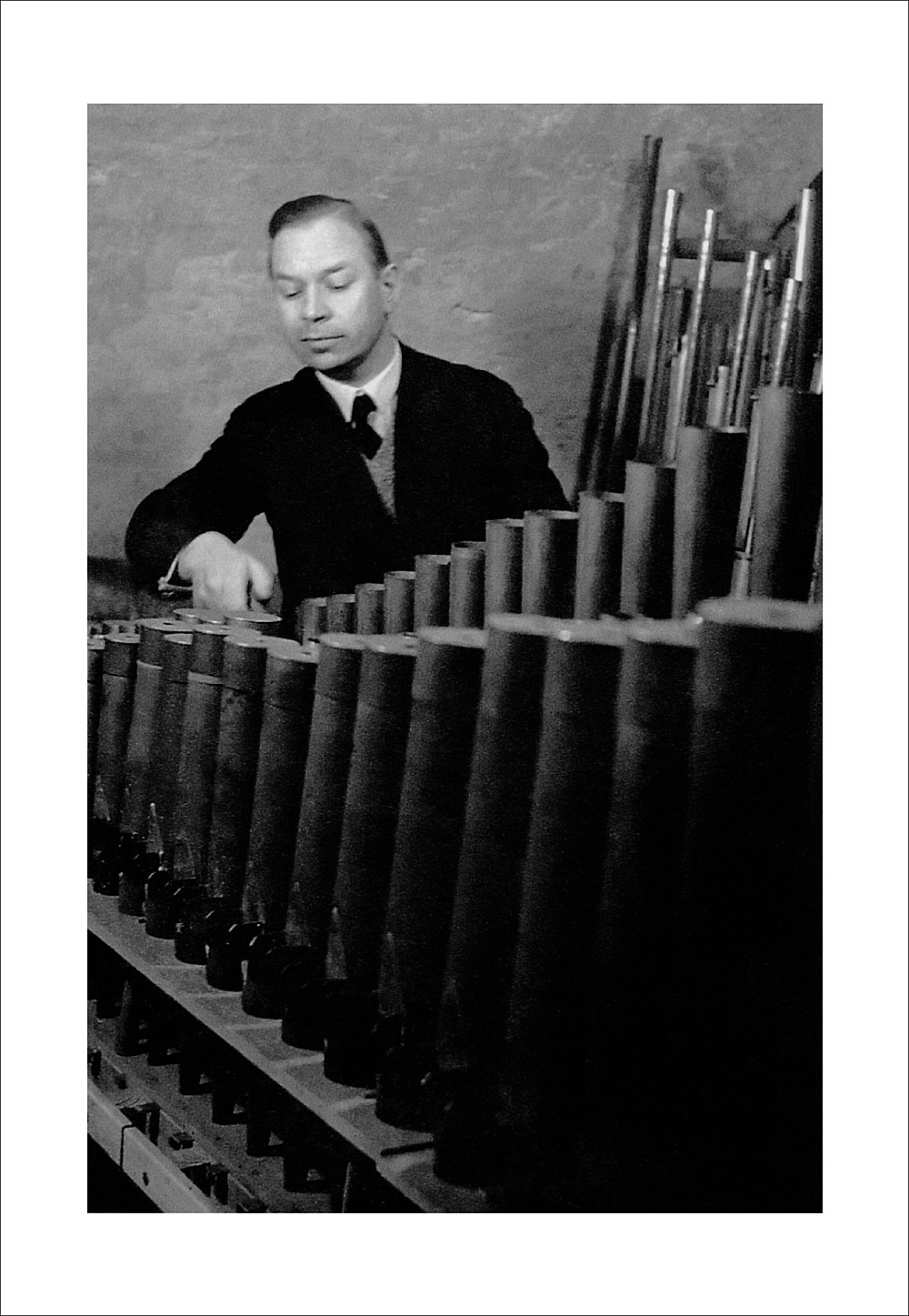
Cosmic Communities: Coming Out Into Outer Space -
Homofuturism, Applied Psychedelia & Magic Connectivity
an exhibition organized by
Diedrich Diederichsen &
Christopher Müller
feat. Marcus Behmer, Stefan George, Rainer Werner Fassbinder, Hans Henny Jahnn,
Lutz Bacher, Hans Kayser, Ludwig Gosewitz, Jordan Belson,
Hapshash and the Coloured Coat, The Fool, Rogério Duarte,
The Red Krayola/Mayo Thompson, Walter de Maria, Sigmar Polke,
Emil Schult, Isaac Abrams, John McCracken, Pedro Bell, Kai Althoff,
Henrik Olesen, Öyvind Fahlström, Karlheinz Stockhausen, Sun Ra,
Hartmut Geerken, Albert Oehlen, Jack Goldstein, Jutta Koether,
Isa Genzken, Palermo, John Coltrane, Tony Conrad
2 November 2017 -
13 January 2018
opening reception on Thursday,
2 November 6-8 pm
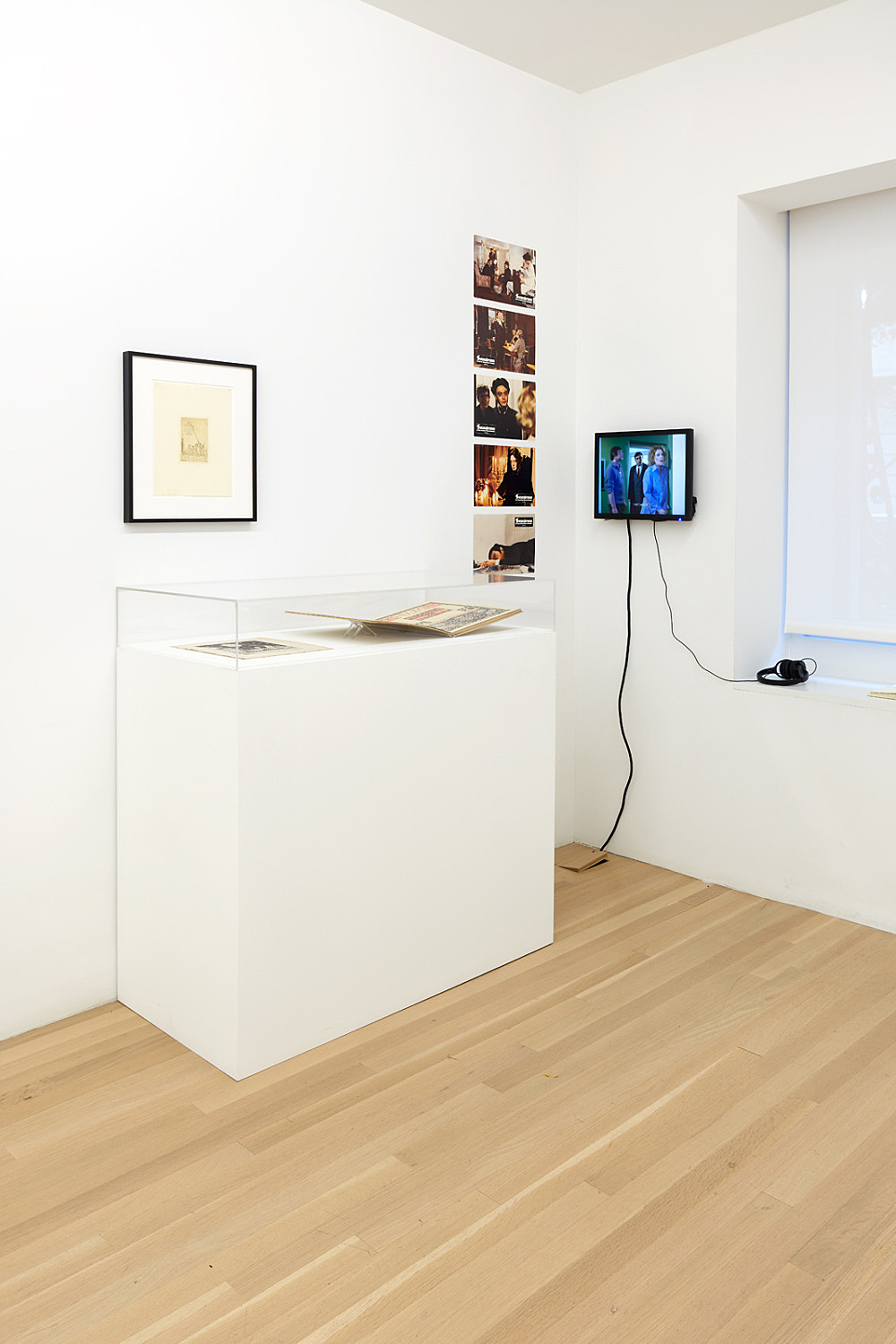
Cosmic Communities: Coming Out Into Outer Space -
Homofuturism, Applied Psychedelia & Magic Connectivity
installation view Galerie Buchholz, New York 2017

Vitrine:
Stefan George
Marcus Behmer
“Prometheus / Karl Wolfskehl als Lichtbringer mit George und Kreis (Prometheus / Karl Wolfskehl as Lightbringer with George and Circle)”, n.d. (ca. 1900)
ink on paper
print size: 20.5 x 16 cm, paper size: 29.5 x 25 cm
&
Stefan George
“Maximin: ein Gedenkbuch (Maximin: A Memorial Book)”
Blätter für die Kunst, Berlin, 1907
34.5 x 26.5 cm
installation view Galerie Buchholz, New York 2017

Marcus Behmer
“Prometheus (Stefan George)”, 1908
etching
print size: 12.5 x 9 cm, paper size: 29.2 x 21.8 cm

Cosmic Communities: Coming Out Into Outer Space -
Homofuturism, Applied Psychedelia & Magic Connectivity
installation view Galerie Buchholz, New York 2017

Lutz Bacher
“Organ Pipes”, 2014
tin, foam, foamcore
part 1: 27 x 270 x 102 cm
part 2: 15.5 x 270 x 101 cm
detail

Lutz Bacher
“Organ Pipes”, 2014
tin, foam, foamcore
part 1: 27 x 270 x 102 cm
part 2: 15.5 x 270 x 101 cm
detail

Cosmic Communities: Coming Out Into Outer Space -
Homofuturism, Applied Psychedelia & Magic Connectivity
installation view Galerie Buchholz, New York 2017

Kai Althoff
“Erwachsen Werden, Fabio (Growing Up, Fabio)”, 1991
acrylic, pencil on paper
16 parts, each
29.5 x 42 cm
&
Workshop / Kai Althoff
“People take action to receive certain results, …”
Finlayson Tonträger, Köln, 1990
LP record with sleeve

Kai Althoff
“Erwachsen Werden, Fabio (Growing Up, Fabio)”, 1991
acrylic, pencil on paper
16 parts, each
29.5 x 42 cm

Cosmic Communities: Coming Out Into Outer Space -
Homofuturism, Applied Psychedelia & Magic Connectivity
installation view Galerie Buchholz, New York 2017

Cosmic Communities: Coming Out Into Outer Space -
Homofuturism, Applied Psychedelia & Magic Connectivity
installation view Galerie Buchholz, New York 2017

Jordan Belson
“Brain Drawings”, 1952
ink on paper
12 works, each approx.
24.8 x 24.8 cm
installation view Galerie Buchholz, New York 2017

Cosmic Communities: Coming Out Into Outer Space -
Homofuturism, Applied Psychedelia & Magic Connectivity
installation view Galerie Buchholz, New York 2017

Öyvind Fahlström
“Improvisations for Nightmusic”, ca. 1975
ink on paper
8 works, each 19 x 23 cm
installation view Galerie Buchholz, New York 2017

Sun Ra
design for record sleeve: “Angels and Demons At Play”
El Saturn Records, 1967
offset print on metallic paper
31 x 32 cm

Cosmic Communities: Coming Out Into Outer Space -
Homofuturism, Applied Psychedelia & Magic Connectivity
installation view Galerie Buchholz, New York 2017

Cosmic Communities: Coming Out Into Outer Space -
Homofuturism, Applied Psychedelia & Magic Connectivity
installation view Galerie Buchholz, New York 2017

Cosmic Communities: Coming Out Into Outer Space -
Homofuturism, Applied Psychedelia & Magic Connectivity
installation view Galerie Buchholz, New York 2017

Sigmar Polke
“Telefonzeichnung, ‘Gespräch’ (Telephone drawing, ‘Conversation’)”, 1975
mixed media on cardstock
96 x 67.5 cm

Cosmic Communities: Coming Out Into Outer Space -
Homofuturism, Applied Psychedelia & Magic Connectivity
installation view Galerie Buchholz, New York 2017
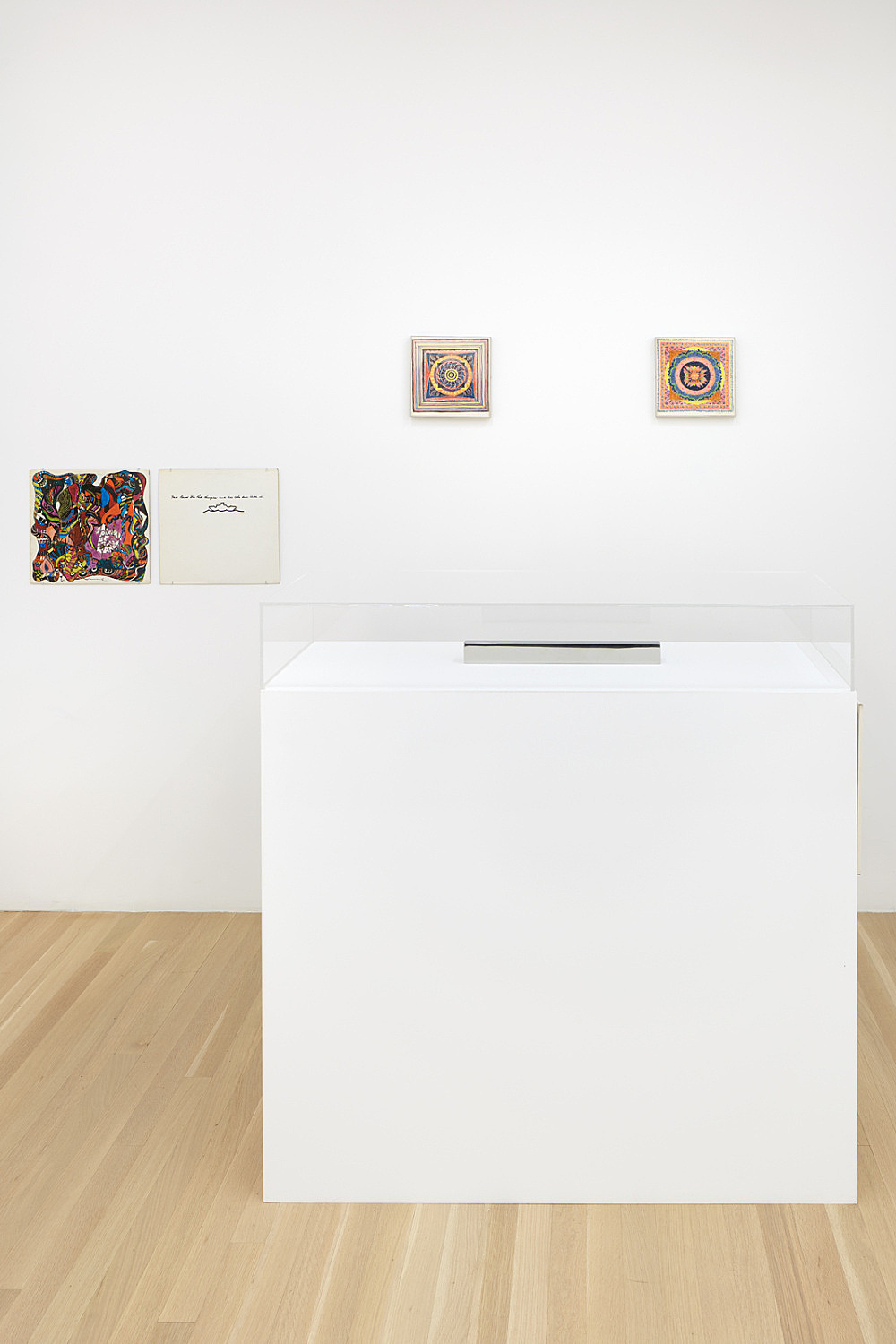
Cosmic Communities: Coming Out Into Outer Space -
Homofuturism, Applied Psychedelia & Magic Connectivity
installation view Galerie Buchholz, New York 2017

Cosmic Communities: Coming Out Into Outer Space -
Homofuturism, Applied Psychedelia & Magic Connectivity
installation view Galerie Buchholz, New York 2017

The Red Krayola
“God Bless The Red Krayola And All Who Sail With It”
International Artists, 1968
LP record with sleeve
cover drawing by Mayo Thompson

Cosmic Communities: Coming Out Into Outer Space -
Homofuturism, Applied Psychedelia & Magic Connectivity
installation view Galerie Buchholz, New York 2017

Fats Domino
“Million Sellers Volume 3”
Liberty, 1968
LP record with sleeve
design by Hapshash and the Coloured Coat

Cosmic Communities: Coming Out Into Outer Space -
Homofuturism, Applied Psychedelia & Magic Connectivity
installation view Galerie Buchholz, New York 2017

Rogério Duarte
Karlheinz Stockhauen
Mary Bauermeister
installation view Galerie Buchholz, New York 2017

Cosmic Communities: Coming Out Into Outer Space -
Homofuturism, Applied Psychedelia & Magic Connectivity
installation view Galerie Buchholz, New York 2017

Mary Bauermeister
costume design for Karlheinz Stockhausen, “Sirius”, n.d.
drawing on paper
approx. 30.6 x 43.2 cm

Mary Bauermeister
costume design for Karlheinz Stockhausen, “Sirius”, n.d.
drawing on paper
approx. 30.6 x 43.2 cm

Mary Bauermeister
costume design for Karlheinz Stockhausen, “Sirius”, n.d.
drawing on paper
approx. 30.6 x 43.2 cm

Mary Bauermeister
costume design for Karlheinz Stockhausen, “Sirius”, n.d.
drawing on paper
approx. 30.6 x 43.2 cm

Mary Bauermeister
costume design for Karlheinz Stockhausen, “Sirius”, n.d.
drawing on paper
approx. 30.6 x 43.2 cm

Mary Bauermeister
costume design for Karlheinz Stockhausen, “Sirius”, n.d.
drawing on paper
approx. 30.6 x 43.2 cm

Mary Bauermeister
costume design for Karlheinz Stockhausen, “Sirius”, n.d.
drawing on paper
approx. 30.6 x 43.2 cm

Mary Bauermeister
costume design for Karlheinz Stockhausen, “Sirius”, n.d.
drawing on paper
approx. 30.6 x 43.2 cm

Karlheinz Stockhausen
performance documentation of “Sirius”, 1976
Suzanne Stephens (bass clarinet)
exhibition print

Karlheinz Stockhausen
performance documentation of “Sirius”, 1976
Suzanne Stephens (bass clarinet)
exhibition print

Karlheinz Stockhausen
performance documentation of “Sirius”, 1976
Suzanne Stephens (bass clarinet)
exhibition print

Karlheinz Stockhausen
performance documentation of “Sirius”, 1976
Suzanne Stephens (bass clarinet)
exhibition print
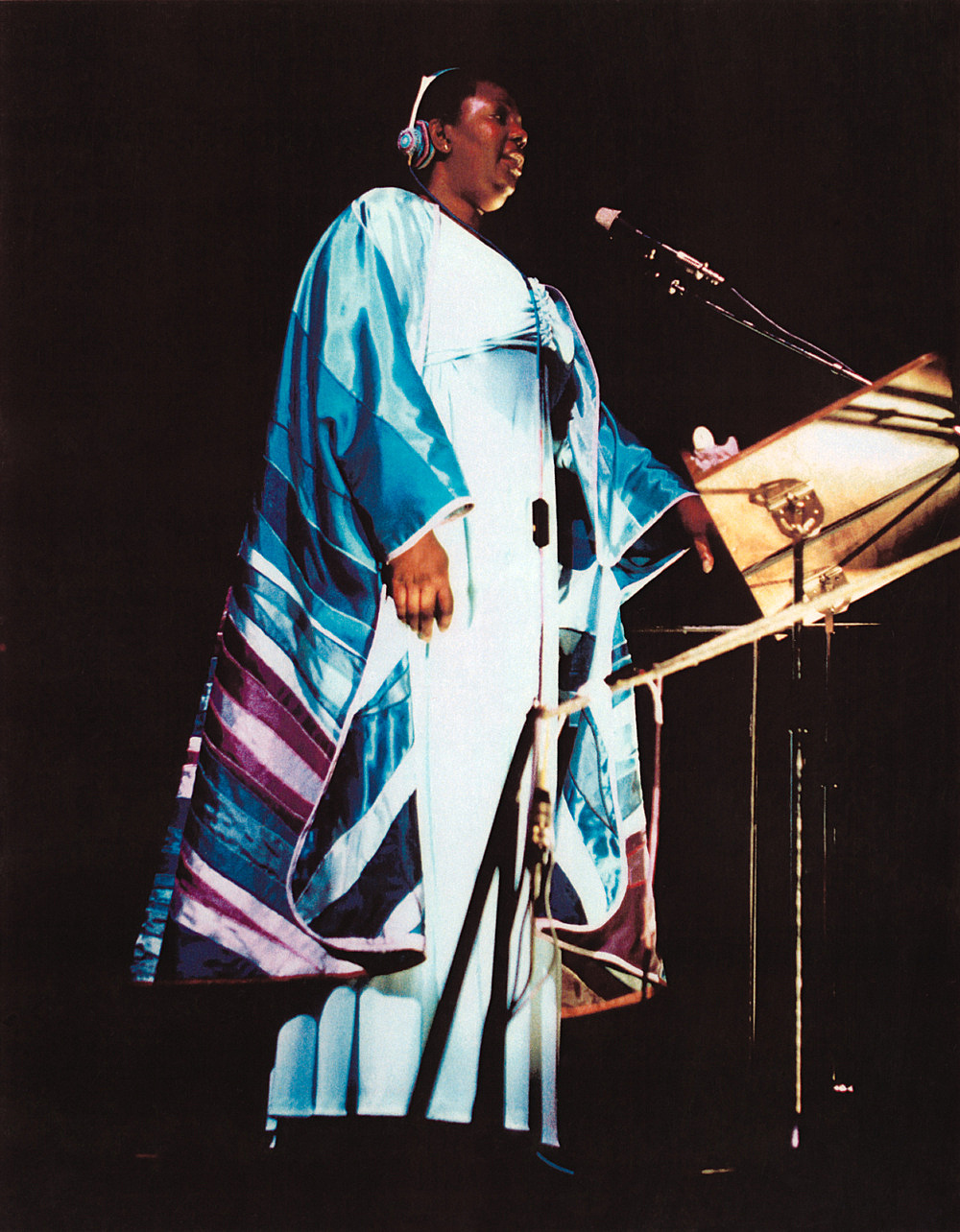
Karlheinz Stockhausen
performance documentation of “Sirius”, 1976
Annette Meriweather (soprano)
exhibition print

Karlheinz Stockhausen
performance documentation of “Sirius”, 1976
Markus Stockhausen (trumpet)
exhibition print
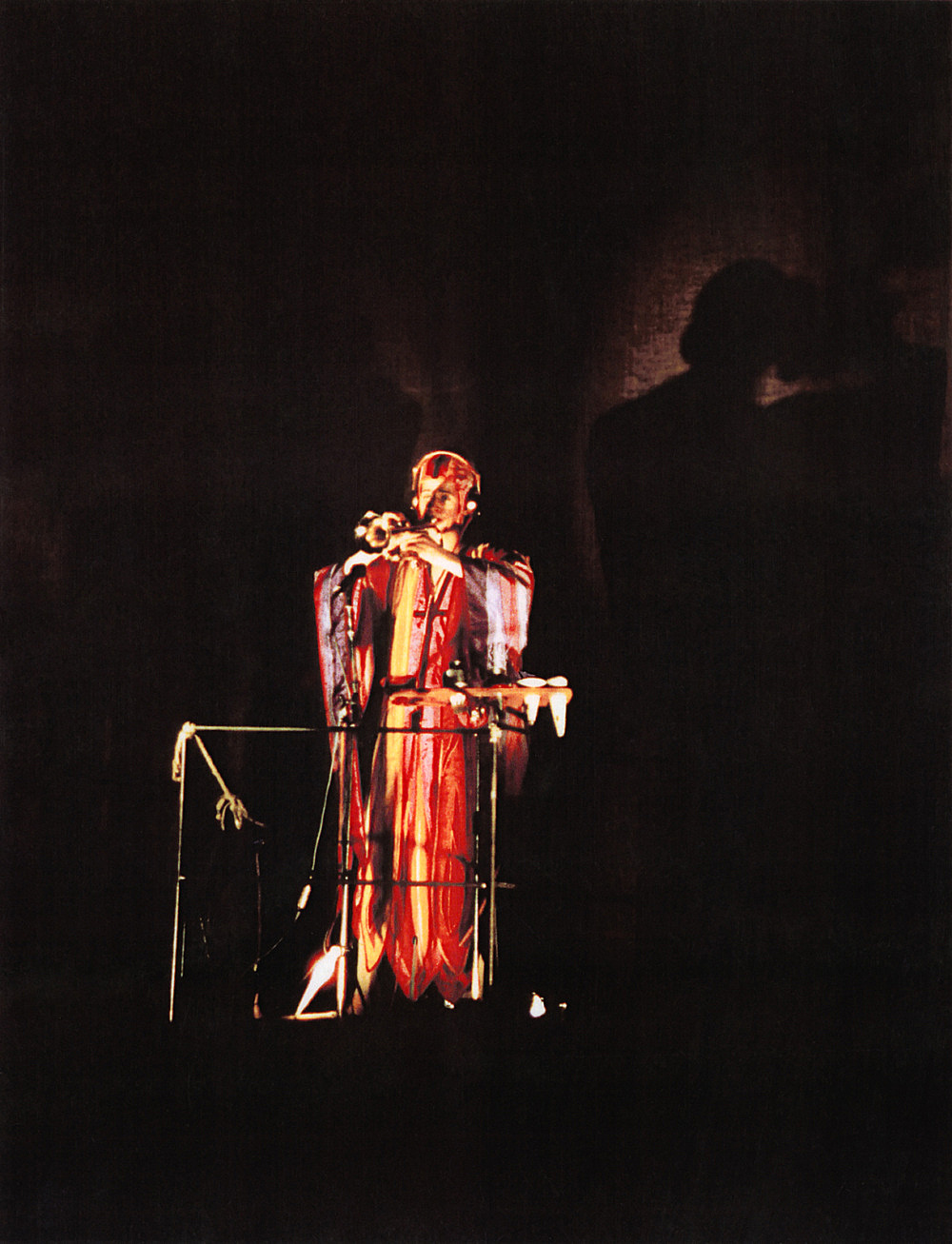
Karlheinz Stockhausen
performance documentation of “Sirius”, 1976
Markus Stockhausen (trumpet)
exhibition print
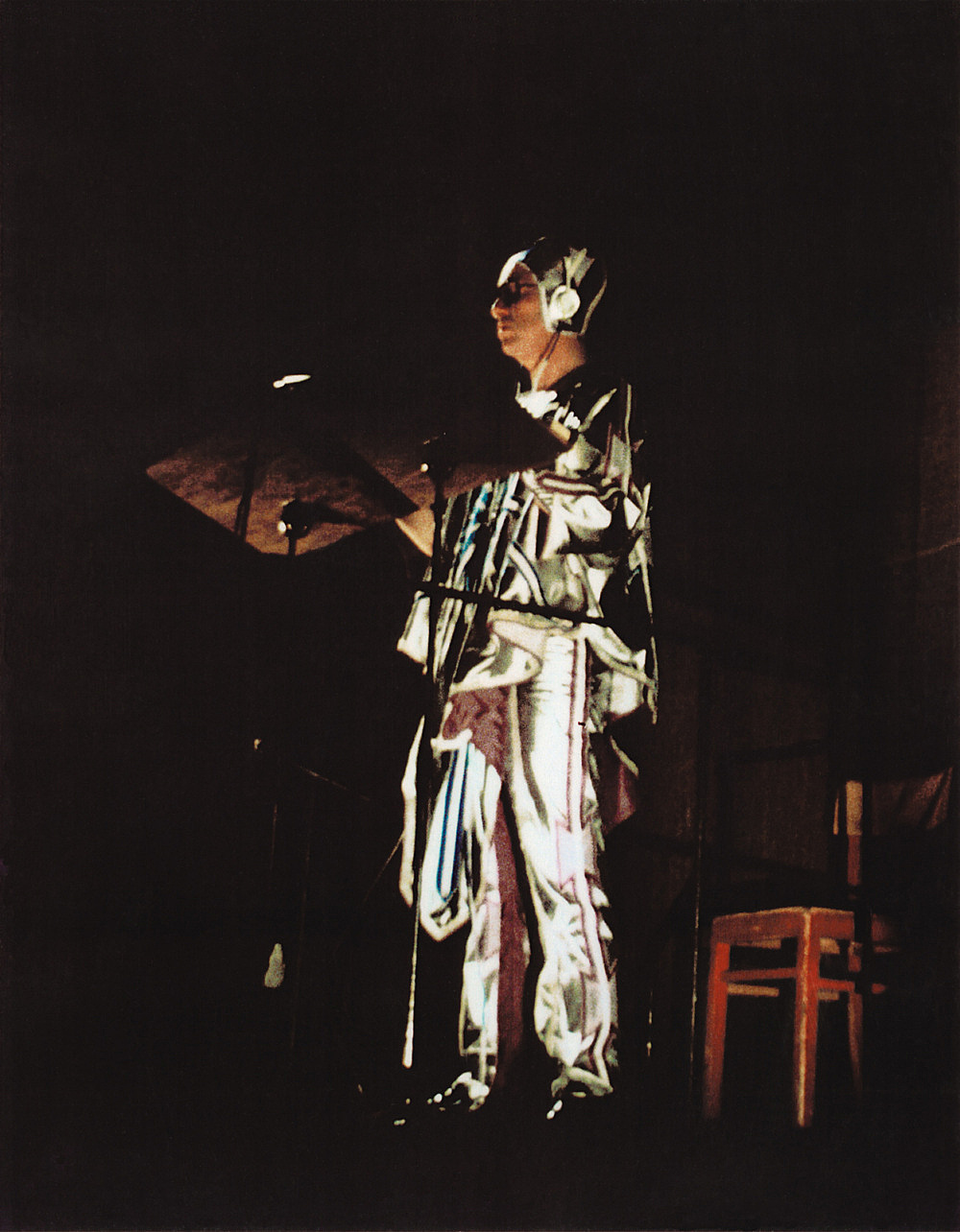
Karlheinz Stockhausen
performance documentation of “Sirius”, 1976
Boris Carmeli (bass)
exhibition print

Tony Conrad
“Fair Ground Electric Horn”, 2003
large funnel, hose clamps, copper tubing, metal mouthpiece
182 x 121.5 x 55.9 cm
installation view Galerie Buchholz, New York 2017

Cosmic Communities: Coming Out Into Outer Space -
Homofuturism, Applied Psychedelia & Magic Connectivity
installation view Galerie Buchholz, New York 2017

Emil Schult
cover design for Kraftwerk, “Radioactivity”, 1974-75
paint, spraypaint on cardboard
image: 30 x 30 cm, paper:
36 x 33 cm

Pedro Bell
cover design for Funkadelic, “Cosmic Slop”, 1973
offset print
94 x 49.5 cm
exhibition copy by the artist

Cosmic Communities: Coming Out Into Outer Space -
Homofuturism, Applied Psychedelia & Magic Connectivity
installation view Galerie Buchholz, New York 2017

Vitrine:
Sun Ra / Hartmut Geerken
Hartmut Geerken
53 photographs of Sun Ra Arkestra performing at Heliopolis/Egypt, December 12, 1971 and Balloon Theater, Cairo, December 17, 1971
installation view Galerie Buchholz, New York 2017

Hartmut Geerken
photograph of Sun Ra Arkestra performing at Balloon Theater, Cairo, December 17, 1971

Hartmut Geerken
photograph of Sun Ra Arkestra performing at Balloon Theater, Cairo, December 17, 1971

Hartmut Geerken
photograph of Sun Ra Arkestra performing at Balloon Theater, Cairo, December 17, 1971

Vitrine:
Sun Ra / John Coltrane
Hartmut Geerken
“Omniverse Sun Ra”
first edition, 1994
left: Val Wilmer. John Gilmore, Morton Street, Philadelphia, June 1979
right: Val Wilmer. Marshall Allen do the ‘numbers’. Morton Street. Philadelphia,
June 1979
&
John Coltrane
“The Circle of Fifths”, 1961
2 diagrams
installation view Galerie Buchholz, New York 2017

Cosmic Communities: Coming Out Into Outer Space -
Homofuturism, Applied Psychedelia & Magic Connectivity
installation view Galerie Buchholz, New York 2017

Sun Ra
design for record sleeve: “My Brother the Wind”, front, 1970
offset printed paper on cardboard
33 x 48 cm

Sun Ra
design for record sleeve: “My Brother the Wind”, back, 1970
offset printed paper on cardboard
33 x 48 cm

Sun Ra and his Myth Science Arkestra
“Disco 3000”
El Saturn Records, 1978
LP record with sleeve
self-published

Jutta Koether
“The Necessity of Multiple Inconsistent Fantasies #14”, 2008
acrylic, liquid glass on wood
25 x 30 cm

Jutta Koether
“The Necessity of Multiple Inconsistent Fantasies #13”, 2008
acrylic, liquid glass on wood
25 x 30 cm

Jutta Koether
“The Necessity of Multiple Inconsistent Fantasies #20”, 2008
acrylic, liquid glass on wood
25 x 30 cm

Tony Conrad
“Equal Tempered Twelve-tone Mesolabe”, ca. 2002
wood, wire, tuning key, screws
54 x 130 x 4.5 cm

Isa Genzken
“Violet-grey Ellipsoid”, 1978
ink on paper
70 x 100 cm
(framed 77.5 x 108 x 3.8 cm)
&
“Weltempfänger (World Receiver)”, 1982
radio
37 x 51 x 20 cm
installation view Galerie Buchholz, New York 2017




